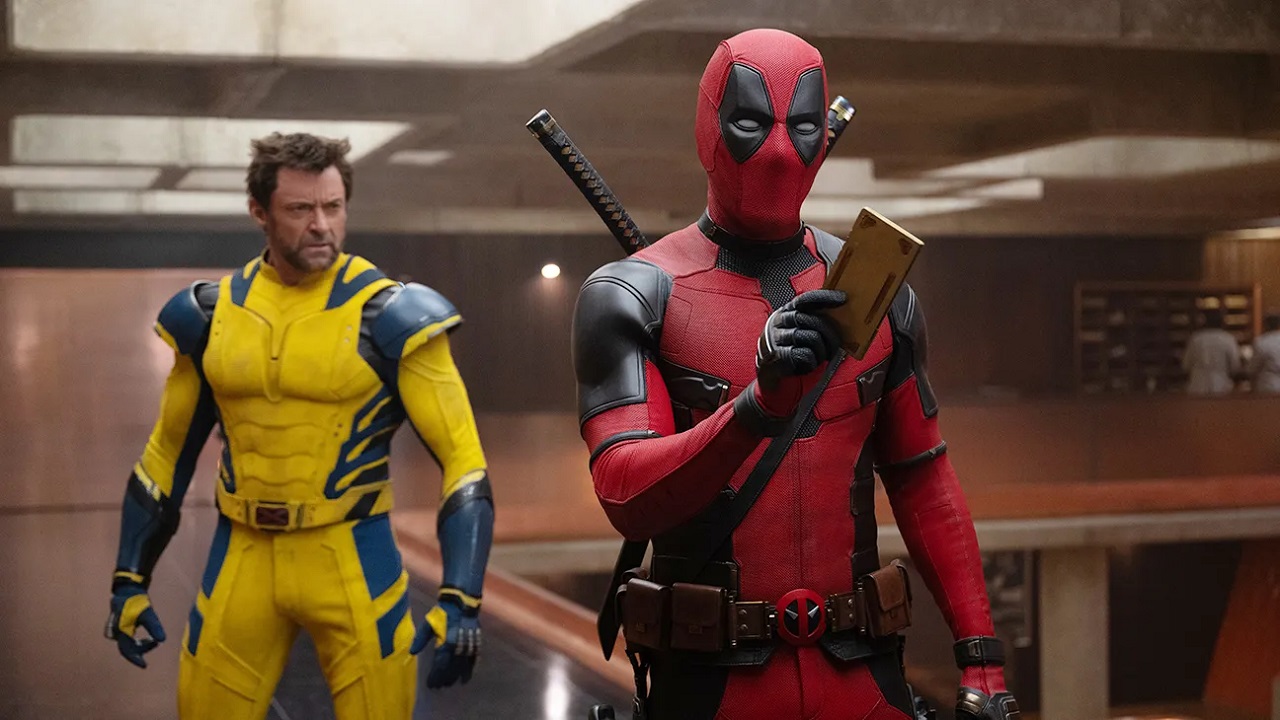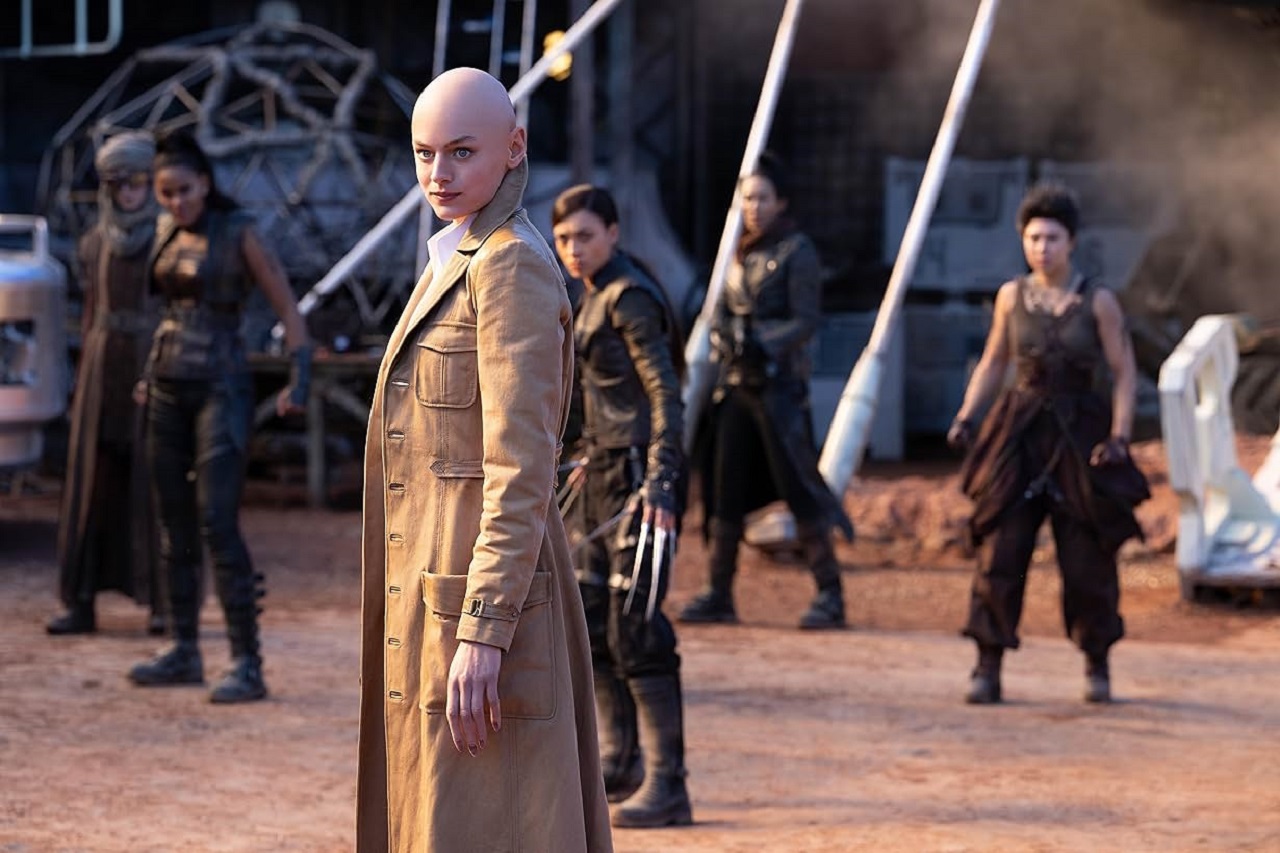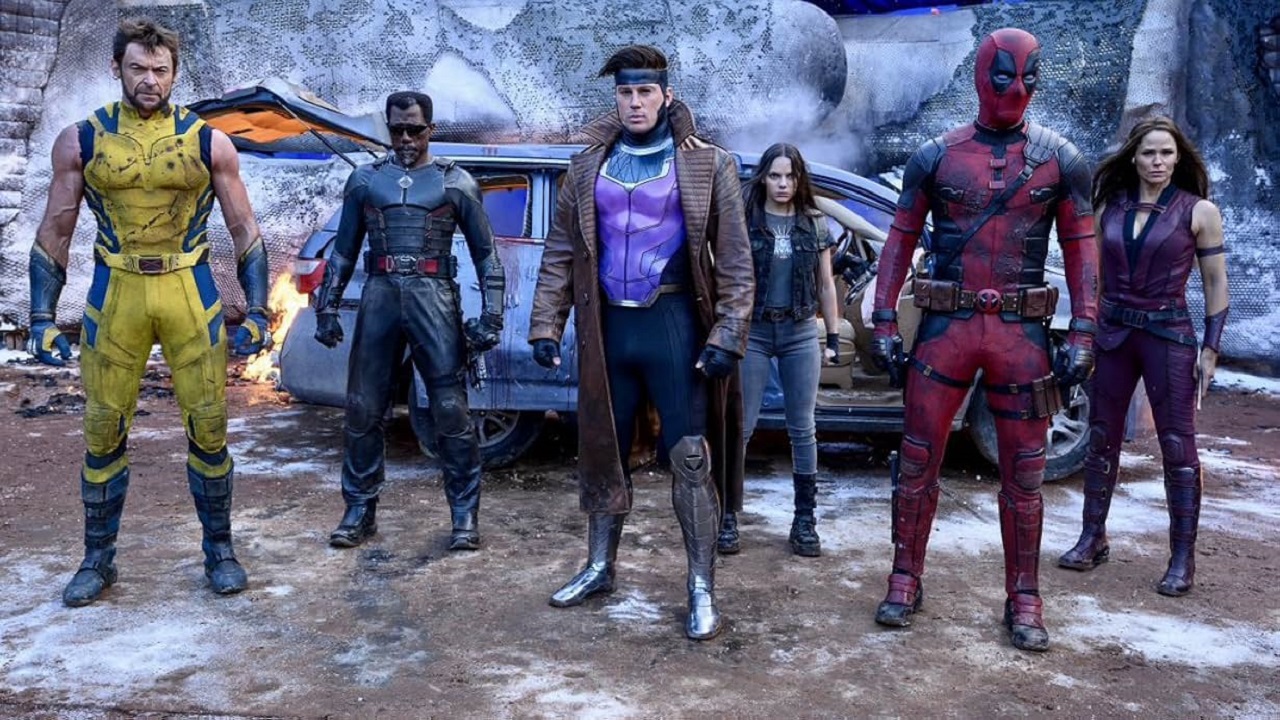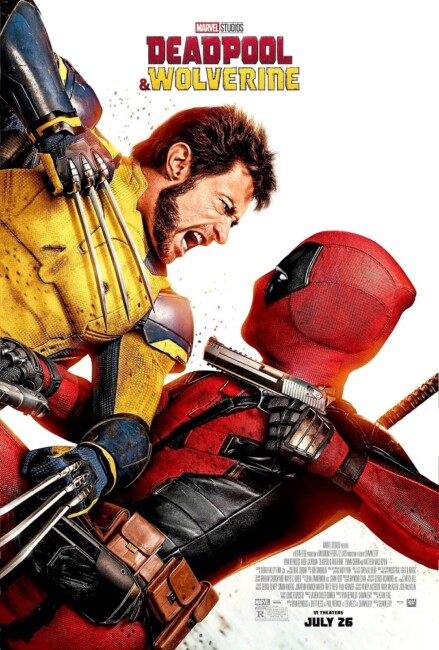USA. 2024.
Crew
Director – Shawn Levy, Screenplay – Shawn Levy, Rhett Reese & Ryan Reynolds, Zeb Wells & Paul Wernick, Producers – Lauren Shuler Donner, Kevin Feige, Shawn Levy & Ryan Reynolds, Photography – George Richmond, Music – Rob Simonsen, Visual Effects Supervisor – Swen Gillberg, Visual Effects – Barnstorm VFX, Base FX (Supervisor – Jared Sandrew & Xu Li), Cantina Creative (Supervisor – Tony Luponi), Capital T, Framestore (Supervisor – Robert Allman, Arek Komorowski, Joao Sita & Matthew Twyford, Animation Supervisor – Jye Skinn), Industrial Light and Magic (Supervisor – Vincent Papaix, Animation Supervisor – Alexander Poei) & Weta FX Ltd (Supervisor – Daniel McCarin), Visual Effects – Lola | VFX (Supervisor – Edson Williams), Raynault FX, Rising Sun Pictures (Supervisor – Jamie MacDougall) & SDFX, Special Effects Supervisor – Dominic Tuohy, Production Design – Raymond Chan. Production Company – Marvel Studios/20th Century Studios/TSG Entertainment.
Cast
Ryan Reynolds (Deadpool/Wade Wilson), Hugh Jackman (Wolverine/Logan), Emma Corrin (Cassandra Nova), Matthew McFadyen (Mr. Paradox), Morena Baccarin (Vanessa Carlysle), Dafne Keen (Laura/X23), Rob Delaney (Peter Wisdom), Leslie Uggams (Blind Al), Jon Favreau (Happy Hogan), Jennifer Garner (Elektra), Channing Tatum (Gambit), Wesley Snipes (Blade), Chris Evans (Johnny Storm), Wunmi Mosako (B-15), Tyler Mane (Sabretooth), Aaron W. Reed (Juggernaut), Aaron Stanford (Pyro), Karan Soni (Dopinder), Brianna Hildebrand (Negasonic Teenage Warhead), Shioli Kutsuna (Yukio), Stefan Kapicic (Voice of Colossus), Randal Reeder (Buck)
Plot
Deadpool is rejected in his application to join The Avengers. He returns to Earth 10005 and retires as Deadpool to become a used car salesman. During his birthday party, he is snatched by Mr. Paradox of the Time Variance Authority. Mr. Paradox reveals that Deadpool’s timeline is about to be shut down. He offers Deadpool the chance to merge with the Sacred Timeline on Earth 616. Deadpool objects that this means that all the people he loves will be erased. Mr. Paradox explains this is due to the anchor being of his timeline, Wolverine, dying. Deadpool snatches one of the control devices that opens the way between universes and sets out to rescue Wolverine. Paradox then banishes Deadpool and Wolverine to The Void, which is ruled over by Cassandra Nova, the deranged twin sister of Charles Xavier. To combat Cassandra and escape to stop Paradox before he erases his universe, Deadpool and Wolverine must combine forces with other cancelled superheroes that have been abandoned in The Void.
So a little back history. The massive output of Marvel superheroes on the big screen all began with Blade (1998). This was followed by the big hit of X-Men (2000). It not be until 2008 before Marvel consolidated its hold on its characters and created a shared universe beginning with The Incredible Hulk (2008) and the launched MCU proper with Iron Man (2008). A number of the works produced during this period 1988-2008 – the Blade and X-Men series, the Spider-Man films beginning with Spider-Man (2002), Daredevil (2003) and 20th Century Fox’s Fantastic Four (2005) and sequel – all fall outside of the copyrights held by the MCU, which is why we never saw said characters appearing in the MCU (although that changed in later years).
The most successful of these non-MCU films was 20th Century Fox’s X-Men series, which consisted of X-Men, X2 (2003), X-Men: The Last Stand (2006), X-Men Origins: Wolverine (2009), X: First Class (2011), X-Men: Days of Future Past (2014), X-Men: Apocalypse (2016), X-Men: Dark Phoenix (2019) and The New Mutants (2020). The unequivocal star of the series was Hugh Jackman’s Wolverine. Jackman was a complete unknown at the time he was cast but became an A-list name as a result. Naturally, the popularity of Wolverine was highlighted in the sequels with Jackman returning to appear in character through each of the films before ending his run with Apocalypse. The character enjoyed such popularity he was spun out as the star in several films, beginning with the prequel X-Men Origins: Wolverine, which tells a Wolverine origin story, followed by the standalone films The Wolverine (2013) and Logan (2017). The latter was intended as Jackman’s sign-off on the character that killed Wolverine off because he felt that he was aging out of the role.
Another successful pendant to the X-Men series were the Deadpool films, also released under the 20th Century Fox banner and produced by the Donners Company and Simon Kinberg, who were behind the X-Men films. Ryan Reynolds first appeared as Deadpool in X-Men Origins: Wolverine but was so disappointed at the watered-down depiction of the character that he personally oversaw the two solo films Deadpool (2016) and Deadpool 2 (2018), both of which are highly enjoyable and get the nature of the comic-book down right. The team-up between Deadpool and Wolverine was potentially tipped by Ryan Reynolds’ cameo as Deadpool in the after credits scene in Logan.

20th Century Fox was brought out by Disney in 2019, which meant that the characters held under its copyright banner – the X-Men, Deadpool and the Fantastic Four – could be merged into the MCU. There is some debate before the surprise appearance of Deadpool & Wolverine how exactly the merger with Disney, a studio known for its family friendly product, would affect the R-rating of Deadpool. Apparently not at all and the film was released with an R-rating in the US – incidentally now making Deadpool & Wolverine the top-grossing R-rated film of all time (with the previous Deadpool films currently holding the fifth and sixth spots between them). Ryan Reynolds is back on fine form with wall-to-wall gags about blowjobs, being fingered, gay sex, the need for intimacy coordinators, you name it. It is Deadpool being filthy just the way we like him.
Not to mention, with the Deadpool series so characteristically playing around with Meta-Fiction, we get plentiful gags aimed at the merger with the Disney universe (the Sacred Timeline) – “Disney brought him [Wolverine] back. They’re going to make him do this til he’s ninety” – and at the previous films – at one point, Deadpool snidely refers to Wolverine as “Mr PG-13 – except the last one.” Wolverine also gets the yellow uniform he is most associated with in the comic-books – when Hugh Jackman pulls down the mask, identical to the one in the comic, whereupon Reynold retorts with the side-splitting “What’s the wind resistance on those blowjob handles?”
The basics of Deadpool and Wolverine’s integration into the MCU is expanded out to being another Multiverse Film. The multiverse theme has gained much popularity in superhero films ever since Spider-Man: Into the Spider-Verse (2018) and sequels, showing a team-up between hordes of alternate Spider-Men. An ingenious spin was placed on this with the big hit of Spider-Man: No Way Home (2021), which brought together the actors playing Spider-Man and super-villains from the previous films. Since then, the multiverse theme has been popular in other superhero films including The MCU’s Doctor Strange in the Multiverse of Madness (2022) and Ant-Man and the Wasp: Quantumania (2023) and the DCEU’s The Flash (2023), which also brought together characters from previous DC Comics screen incarnations.

To this extent, we get a number of familiar characters from alternate Marvel cinematic continuities. There’s a 62 year-old Wesley Snipes, who started the Marvel renaissance on the big screen off in Blade, back in character; there’s Jennifer Garner who was the assassin Elektra in Daredevil and then spun off as her own film Elektra (2005); Chris Evans back as Johnny Storm from the Fantastic Four films, naturally with asides about people expecting Captain America; Tyler Mane reprising his role as Sabretooth from X-Men; Dafne Keen, Wolverine’s daughter from Logan; and Jon Favreau back as Happy Hogan. There are assorted characters from the Deadpool franchise – Colossus, Negasonic Teenage Warhead, Dopinder, Blind Al – back. We get a few recastings of familiar roles – the one that works the best is Channing Tatum as Gambit (as opposed to Taylor Kitsch in X-Men Origins: Wolverine) and a series of action scenes that actually give Gambit some balls as a superhero. There are assorted other familiar characters making unspeaking appearances during the battle in The Void, including Toad, Psylocke and Lady Deathstroke.
Although surprisingly the one inclusion we don’t get to see, especially given the plethora of alternate Deadpools we get later in the film, is the Deadpool that Ryan Reynolds played in X-Men Origins: Wolverine – I kind of thought that that was the way that Nicepool was meant to be but it is a different character. (It seems a missed opportunity for Reynolds to slag off a character he hated playing as he has done with his outing as Green Lantern (2011) in the other Deadpool films). The big battle with a host of alternate versions of Deadpool seems to have been consciously intended as a live-action equivalent of the assorted alternate Spider-Man variations that we have in the Spider-Verse films.
What you realise part way through is that Deadpool & Wolverine is actually the MCU’s equivalent of Crisis on Infinite Earths (1985-6), the comic-book event that DC Comics created to harmonise their multiverse and characters variants, which had become absurdly complicated. In their version, DC created a cosmic super-villain that was devouring the different universes, whereas here we get a more down-to-earth villain doing so with a device. In both, we get plots where superheroes of various timelines unite forces to face the threat and an end that results in the merging of the multiverse into one timeline. It should also be noted that Crisis on Infinite Earths had recently been given an animated adaptation as part of the big interest in multiverse films with Justice League: Crisis on Infinite Earths Part One (2024) and sequels.

I have remained divided in my liking of Shawn Levy as a director. He has made some incredible throwaway junk – Big Fat Liar (2002), Just Married (2003), Cheaper By the Dozen (2003), a terrible revival of The Pink Panther (2006) and the Night at the Museum films. Real Steel (2011), his previous outing with Hugh Jackman was okay, and I did like quite a lot Levy’s first team-up with Ryan Reynolds Free Guy (2021), although their subsequent The Adam Project (2022) was just another forgettable lightweight effort. (See below for Shawn Levy’s other films). However, Levy is on form in a big way here, getting the characteristic tone of the previous films down perfect – you could run all three Deadpool films together and not know that they had different directors.
Levy really shows his hand with the action scenes – be it the opening scene with Deadpool eliminating hordes of TVA agents using the bones of Wolverine’s adamantium skeleton as an improvised weapon where the flying bones and splatters of blood form into the credits to the large-scale assault on Cassandra’s wilderness fortress by the combined team of abandoned superheroes. There is a particularly funny sequence with a fight between Deadpool and Wolverine that takes place inside the Honda Odyssey – which in itself forms an ongoing gag throughout – that fairly much succeeds in wrecking the car. Although the sequence that caps the film is the hilariously all-out battle with Deadpool and Wolverine taking on the massed horde of alternate Deadpools.
Shawn Levy is a director who emerged through a good many easy, middle-of-the-road comedies with the likes of Big Fat Liar (2002), Cheaper By the Dozen (2003), Just Married (2003), The Pink Panther (2006), Date Night (2010), The Internship (2013) and This is Where I Leave You (2014). He has ventured into genre material with the popular family-friendly hit of Night at the Museum (2006) and made both its sequels Night at the Museum 2 (2009) and Night at the Museum: Secret of the Tomb (2014). In between these, Levy also made the likeable robot boxing film Real Steel (2011) and previously collaborated with Ryan Reynolds for Free Guy (2021) and the time travel film The Adam Project (2022). Levy has also worked as a producer with genre efforts like The Watch (2012), the Young Adult The Darkest Minds (2018), Denis Villeneuve’s Arrival (2016), The Boogeyman (2023), Crater (2023), Never Let Go (2024) and the tv series’ Stranger Things (2016-25) and Shadow and Bone (2021-3).
(Winner in this site’s Top 10 Films of 2024 list).
Trailer here


